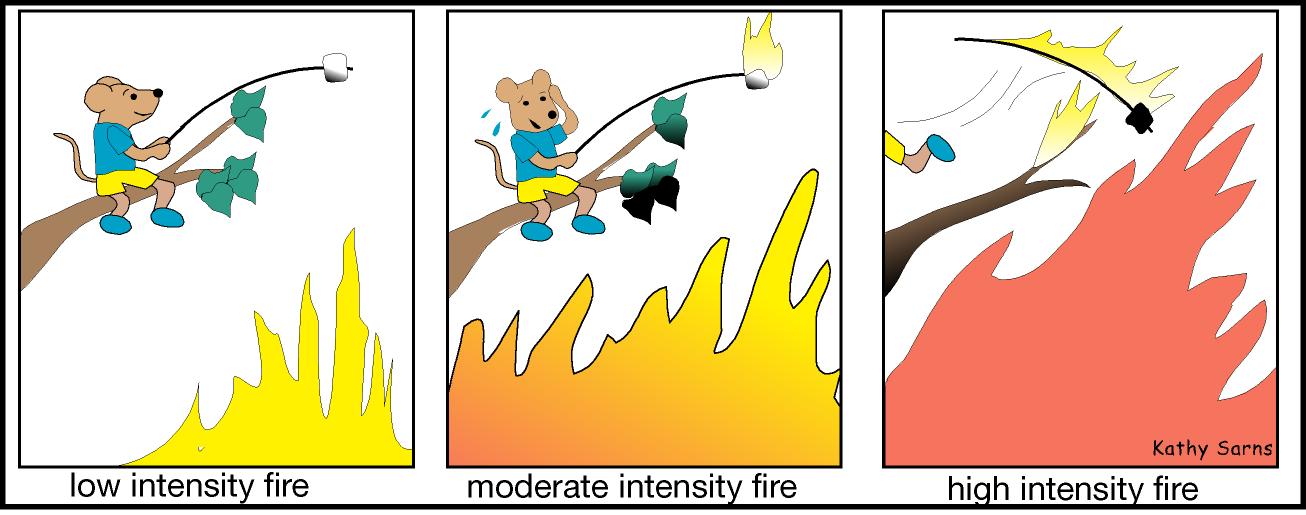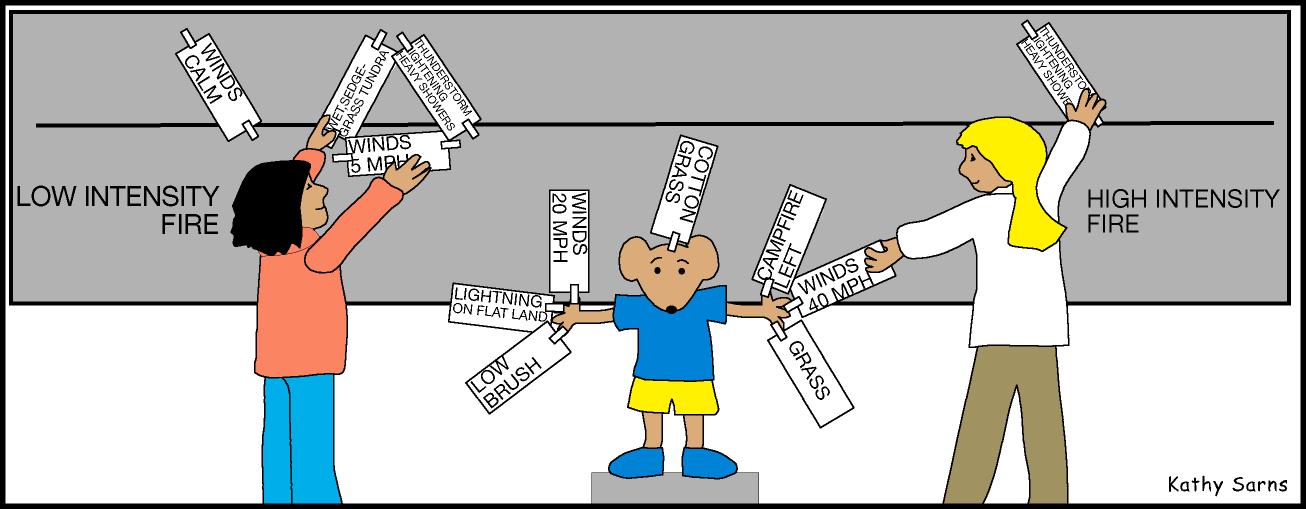
|
 |

| Grade Level: 8-12 |
| Alaska State Content Standards: SA15, GeoF3 |
| Subject: Science |
| Skills: Application, Classification, Description |
| Duration: 1 class period |
| Group Size: 1-4 |
| Setting: indoors |
| Vocabulary: fire intensity, low intensity fire, moderate intensity fire, high intensity fire, crown fire, ground fire, surface fire, canopy fire. |
OBJECTIVE
Students willdescribe the factors that affect fire intensity.
TEACHING STRATEGY
Students use cards to create a fire intensity line.
MATERIALS
![]() Tundra and Forest Fire Component Cards
Tundra and Forest Fire Component Cards
![]() Tundra Fire Fact Sheet
Tundra Fire Fact Sheet
![]() Forest Fire Fact Sheet
Forest Fire Fact Sheet
Small pieces of paper and tape
TEACHER BACKGROUND
Fire intensity is a term used to describe the amount
of heat a fire produces - it will be a hot, cool, or moderate fire
Most people have heard about the fire that burned out of control near Tok, Alaska, during the summer of 1990. There have been many other fires in Alaska that firefighters were not able to stop. These fires are often controlled only after a change in weather helps to cool the fire. What makes these fires burn so hot? Topography, ground slope, humidity, temperature, and the amount of fuel all work together to determine fire intensity.
Topography is important when discussing fire intensity. Slopes that face south, southwest, and west tend to be warmer and drier because they receive more sun. Fires on these slopes will burn more readily than fires on north-facing slopes. Fire will burn up a steep slope more rapidly than on level ground because the fire and heat move up more quickly and dry out the vegetation.
Moisture in the air and air temperature also affect how fuels burn. Fires that occur in the spring burn less intensely than fires during the dry summer months because of lower temperatures and increased moisture in the soil and air. While rain can cause fires to cool down and lessen in intensity wind can fan a fire and cause the intensity to increase.
A low intensity fire means that the fire is burning slowing and is not very hot. These usually occur in moist areas, in wetter months, low winds, and minimal fuels.
A moderate intensity fire is faster burning and very hot. They usually occur in dryer months and in moderately dry conditions. There are adequate fuels to continue the fire.
A high intensity fire is one that burns very fast and extremely hot. These usually occur in dry months with dry soils and a large amount of fuels. These fires are very hard to contain and ignite other areas quickly often traveling great distances.
The amount and condition of available fuels will also influence fire intensity. There are three basic types of fires: surface, ground, and canopy (crown) fires. Each burns differently depending on the kind of fuel present.
A surface fire burns fuels that are on the ground as well as shrubs and trees. Fuels small in size and very dry (e.g. branches, bark, broken and downed trees, dead shrubs, etc.) will cause a fast moving fire. Grass fires generally produce lower temperatures and burn quickly. A fire through brush such as alder or willow burns quickly with high temperatures because of the woody fuel. Some shrubs, such as Labrador tea, have an oily sap that is very flammable. If a fire burn fast, but without much intensity, the soil and trees are often not damaged. Surface fires can help keep surface fuels from building up and will stimulate herb and shrub regrowth.
A ground fire can occur when the duff layer becomes very dry. Duff is the organic layer of the soil consisting of decaying leaves and other plant parts, dead branches, and wood. It can be from a few inches to several feet thick. A ground fire can creep slowly through the duff, similar to the way charcoal burns. It not only burns the dead leaves and wood, but will also burn the roots of living trees and plants. Generally ground fires are of moderate intensity but, like the charcoal on a grill, can smolder and burn much longer than a surface fire.
A canopy (crown) fire burns the higher leaves and branches of trees and shrubs, moving from tree to tree through the treetops. The worst canopy fires occur in dense forests.
The fire will usually begin in the shrub layer, spreading into the dry, lichen-
covered lower branches and into the canopy. If there is a strong wind the fire can build very quickly. Large fires can create their own winds as they use up large amounts of oxygen and as heat from the fire rises. The winds from these huge fires can flatten stands of trees and scatter them like toothpicks! These fires are so powerful they can create their own weather by heating and drying out vegetation. The moisture rises above the trees and forms cumulus clouds, which can then cause lightning that starts other fires.
PROCEDURE
- This activity is done after the "Fire Triangle" activity. Students use the fire triangle they created in that activity.
- Discuss with students the fuels that create surface, ground, and canopy fires using the "Tundra and Boreal Forest Fire Fact Sheet" for a reference. Talk about fire intensity and the factors that make some fires more intense than others.
- Draw a fire intensity line on the blackboard or bulletin board. Label the left hand side "low intensity fire." Label the right hand side "high intensity fire."
- Students or groups of students will write the three components of their fire triangle on a small piece of paper. They then use the "Tundra and Boreal Forest Fire Fact Sheet" to categorize their fires as surface, ground, or canopy fires. Finally, they will use the heat, oxygen, and fuel information given them on the "Tundra and Boreal Students or groups of students will write the three components of their fire triangle on a small piece of paper. They then use the "Tundra and Boreal Forest Fire Fact Sheet" to categorize their fires as surface, ground, or canopy fires. Finally, they will use the heat, oxygen, and fuel information given them on the "Tundra and Boreal Forest Fire Fact Sheet" to determine their fire's intensity. It may be difficult to distinguish between the intensities of some fire triangles; each fire has its own individual characteristics and is subject to many, often rapidly changing, influences.
- Individual students are to read to the class the components of their fire triangle and the type (surface, ground, or canopy) of fire. They then tape their triangle (slips of paper) onto the fire intensity line. Class discussion may occur if there are questions about where each fire triangle is placed along the line, fires of similar intensity can be clustered together. Students can add magazine pictures of fire to make the intensity line more interesting

VARIATION
Show and discuss a videotape like Northland
Wildfires “lessons Learned” to help
the students visualize what fighting a fire is really like. This videotape and many other resources are available in the Role of Fire
Kit. Then have each student become a
fire boss who must decide what resources they are going to need and how those
resources are going to be deployed.
They must explain all the factors that would enter into this decision. After these papers are written, divide the
class into groups of 3 or 4 students and have them discuss all their
ideas. Now have them explain, to the
class, how the group would fight this fire.
VALUATION
Have the students list as many factors as they can that would affect the intensity of a fire.
| Printable version | Add to favorites | Make Alaska FWS my homepage |
| Site designed and maintained jointly by the USFWS Alaska Region Division of Information Resource Management (IRM) and External Affairs (EA). |